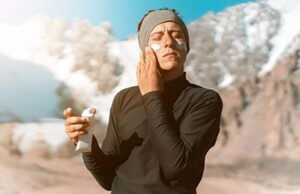Study Conducted by Vail Skin Institute
Are you considering hitting the slopes this spring? When you get the desire to speed down the mountain what are you thinking of? Fresh powder? Bunny slopes or black diamonds? You might be a hot cocoa on the deck kind of skier! Whatever your speed, don’t forget the SPF when you pack up your skis!
 Dr. Aaron Farberg MD, Dr. William Abramovits MD, and Ella Tadjally, PA-C, at Bare Dermatology provide both medical and cosmetic dermatology for our patients in and around North Texas. Dr. Farberg has been a clinical investigator in numerous FDA studies. He conducted a study in Vail, CO, in 2016 to determine the efficacy of high-SPF sunscreen when used in the high altitude of Vail. This study was used by the FDA to determine the final monograph in regulating sunscreen labeling in the US.
Dr. Aaron Farberg MD, Dr. William Abramovits MD, and Ella Tadjally, PA-C, at Bare Dermatology provide both medical and cosmetic dermatology for our patients in and around North Texas. Dr. Farberg has been a clinical investigator in numerous FDA studies. He conducted a study in Vail, CO, in 2016 to determine the efficacy of high-SPF sunscreen when used in the high altitude of Vail. This study was used by the FDA to determine the final monograph in regulating sunscreen labeling in the US.
The Study
In this study, Dr. Farberg, along with Dr. Rigel of the Icahn School of Medicine at Mount Sinai, provided available over-the-counter sunscreen to 199 volunteers. Two different brands with two different SPF ratings were provided; the first sunscreen was SPF 50 and the second sunscreen was SPF 100. In this split-face study, one sunscreen was applied to half of the face and the other sunscreen was applied to the other half of the face.
Before the sunscreen was applied, an evaluation and photograph was taken of the participants. The morning after the test, the participants of the study were photographed a second time.
The results were as follows:
- 110 of the 199 participants showed more sunburn on the SPF 50 side
- 10 of the 199 participants showed more sunburn on the SPF 100 side
- 81 of 199 participants had increased skin redness (erythema) on the SPF 50 side
- 27 of 199 participants had increased skin redness (erythema) on the SPF 100 side
The authors of the study note that it may not be possible to extrapolate the effectiveness of sunscreen in general from a single day of sunscreen testing. However, the results of the study clearly demonstrate that a higher SPF sunscreen provides significant protection from sun exposure and skin damage.
UV Rays
Vail gets 300 days of sunshine per year and has an altitude of 8150 feet above sea level and as high as 11000 feet if you are there to ski. At this elevation, much less atmosphere sits between your skin and harmful UV rays from the sun. For every 1,000 feet above sea level you are, your exposure to UV rays rises by as much as 6 to 8 percent.
Even at lower altitudes, wearing sunscreen every day is important. As the rates of skin cancer continue to rise, protecting your skin from the sunlight and UV rays is important. You should wear the highest SPF sunscreen available to you. Alongside regular sunscreen use, you should make a skin self-check a part of your daily routine. This will allow you to notice changes in your skin more readily and contact us if anything seems out of the ordinary.
Contact Our Dermatologists Today
Dr. Farberg has brought his knowledge of high-altitude sun exposure and sunscreen to Bare Dermatology. Our research has provided a unique perspective on the diagnosis and treatment of skin cancer. When you need a dermatologist in North Texas, you can rely on Dr. Farberg, Dr. Abramovits, and Ella Tadjally, PA-C, at Bare Dermatology are here to provide the professional skin care that you need. If you have any questions or would like to schedule an appointment, call us today at (972) 366-0916.
References
Williams, J. D., Maitra, P., Atillasoy, E., Wu, M. M., Farberg, A. S., & Rigel, D. S. (2018). SPF 100+ sunscreen is more protective against sunburn than SPF 50+ in actual use: Results of a randomized, double-blind, split-face, natural sunlight exposure clinical trial. Journal of the American Academy of Dermatology, 78(5), 902–910.e2. https://doi.org/10.1016/j.jaad.2017.12.062
